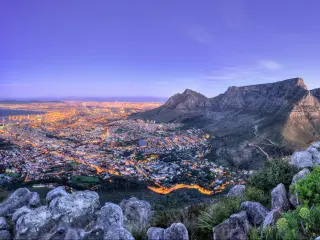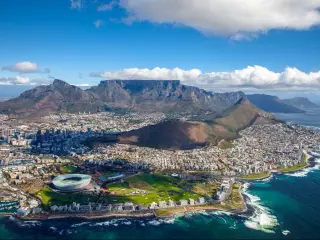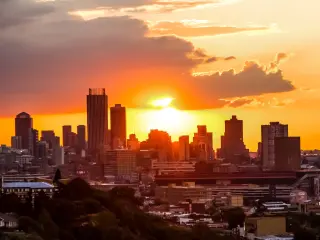15 Best Road Trips from Cape Town
Cape Town, a jewel at the tip of the African continent, is known for its iconic Table Mountain and beautiful waterfront. Its unique position, bordered by mountain ranges and the Atlantic Ocean, makes Cape Town an ideal starting point for a variety of amazing road trips, leading you to discover picturesque landscapes, charming vineyards, and rugged coastlines.
In our list of the 15 best road trips from Cape Town, you will find adventures from leisurely day excursions and weekend getaways admiring rolling vineyards to whale-watching and enjoying the Garden Route and beautiful South African national parks.
These journeys from Cape Town are not just about the destinations but also about the experiences en route. Read on to find out about the must-see attractions, local secrets, and top travel tips. Get ready to hit the road and explore the endless possibilities that await you on a road trip from Cape Town!
Below you will find a shortlist of our favorite road trips from Cape Town, followed by the full list of 15 amazing adventures on the road!
Best road trips from Cape Town
| Trip type | Some of our favorite road trips |
|---|---|
| Day trips | Visit South Africa's Winelands in Stellenbosch; or enjoy endless coastal views to St Helena Bay |
| Weekend trips | Spend some time at De Hoop Nature Reserve; or go whale-watching on the way to Cape Agulhas |
| Long-weekend trips | Drive on the legendary Garden Route to Stormsrivier; or admire the desert views around the Karoo |
| Longer trips | Dip your toes in the sand at the beaches of Gqeberha; or enjoy the urban atmosphere of Johannesburg |
Day trips from Cape Town (under 3 hours each way)
If you're looking for a fun day trip from Cape Town, you've hit the jackpot! Whether you're in the mood for charming winelands, serene beaches, or some rock-climbing, the Mother City is your gateway to an array of nearby adventures.
1. Cape Town to Stellenbosch and Franschhoek
1 hour 25 minutes from Cape Town (90 km)
Why you should visit: The Cape Winelands is renowned for picturesque vineyards and world-class wineries. This region is a great place to visit on a drive from Cape Town with its rolling hills covered in vineyards and delicious foodie offerings.
Stellenbosch and Franschhoek are the beating heart of South Africa's wine country, where legendary wines are made and enjoyed across the globe. But they are not only famous for their wines; they have rich histories, too.
Stellenbosch's Cape Dutch architecture showcases Dutch colonial history, while Franschhoek has remnants of French settler history.

How to get here from Cape Town: Follow N2 to head out of Cape Town and head southeast. Take Exit 33 and merge onto R310, which will take you to Stellenbosch. From here, head towards Pniel and switch to R45 to reach Franschhoek.
Our highlights: Begin your adventure with a visit to the Stellenbosch Village Museum in the heart of Stellenbosch. Painstakingly restored to their original glory, these homes provide a living history lesson, allowing you to step back in time and experience the rich heritage of this historic town.
Next, as you drive between Stellenbosch and Franschhoek, the Helshoogte Pass will be an unforgettable scenic experience. This mountain pass is a photographer's paradise, with every turn revealing a new, breathtaking perspective of the Western Cape's natural beauty.
In Franschhoek, check out the Wine Tram Tour. This hop-on, hop-off tour is a great way to explore the region's famed wineries. Glide through the picturesque Franschhoek Valley aboard the charming tram, visiting various vineyards along the way.
During your visit, don't miss the Huguenot Memorial Monument. This significant monument is a tribute to the French Huguenots and their enduring influence on the region.
Did you know? Franschhoek means "French Corner" and was named after the Huguenots who settled in the area. These French settlers are said to have brought winemaking expertise to the Cape.
Things to note: This region has a warm Mediterranean climate (that agrees with the wine grapes!). The winter months of June, July, and August, can be cooler. Even so, there should be no heavy snowfall.
Keep in mind that some wineries may require reservations for tours and book in advance, if possible. If you are doing a tasting, it is a good idea to make sure you have a designated driver or use local transportation such as the tram tour.
Check for local events or festivals, such as the Stellenbosch Wine Festival in early August, before traveling in case you might want to plan your trip around these fabulous events.
2. Cape Town to Betty's Bay and Gordons Bay
1 hour 35 minutes from Cape Town (95 km)
Why you should visit: This beautiful road trip to Gordon's Bay will take you along Clarence Drive. The scenic drive is lined with coastal views on one side contrasted with the rocky mountains on the other.
As you drive along the coastal route you'll have ample opportunity to stop and enjoy beaches and take a dip into the sea. At the destination of Betty's Bay, you can witness an African penguin colony, a memorable wildlife experience.

How to get here from Cape Town: Follow N2 southeast until you reach Strand. From here, dip towards south through Gordon's Bay and past Clarence Drive Outlook Point and Stony Point. You will soon reach Betty's Bay.
Our highlights: Begin your adventure from Cape Town with a laid-back stop at Gordon's Bay Bikini Beach, a splendid Blue Flag-status beach. Lounge on the soft sands, bask in the sun, and simply enjoy the relaxed atmosphere of this coastal haven.
Continue your journey along the Clarence Drive. This route is a visual feast, with each turn offering a new, stunning view of the rugged cliffs, lush mountains, and the deep blue waters of the ocean. Make sure to pause at the lookout near Rooi-Els to capture the breathtaking scenery.
A visit to the Stony Point Penguin Colony is an experience you won't soon forget! Here you can observe the charming African penguins in their natural habitat, and the surrounding coastal view, which will truly take your breath away.
Once you reach Betty's Bay, you can visit Harold Porter National Botanical Garden. This botanical paradise showcases an array of diverse flora and fauna. Wander along its scenic boardwalks to explore the lush gardens and spot the local wildlife in their natural surroundings.
Did you know? The African penguins at Stony Point have the nickname jackass penguins. This nickname is due to their calls resembling donkey noises.
Things to note: Clarence Drive is prone to high winds, which can cause dangerous driving conditions and lead to closures, especially in winter.
If visiting Harold Porter National Botanical Garden, take note of opening and closing times. For example, in winter, from April to October may close at 6pm while in summer, from November to March, it opens until 7pm.
Peak penguin viewing times are early morning or late afternoon. Remember, as the signs state, check for penguins underneath your car before leaving.
3. Cape Town to Cape Peninsula
Via Table Mountain National Park
1 hour 50 minutes from Cape Town (80 km)
Why you should visit: This coastal road trip from Cape Town to Cape Peninsula features one of the most scenic drives in the country; Chapman's Peak Drive. This drive features curves in the road, revealing lookouts to admire the blue seas set at the foot of mountains.
Table Mountain National Park is a UNESCO World Heritage site and is home to the perhaps familiar landscape of Table Mountain. Boulders Beach, also part of the National Park, is renowned for penguins, where you can spot them in their natural habitat.
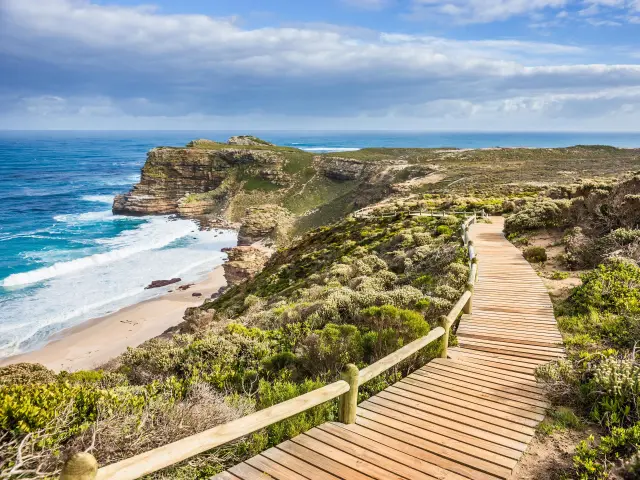
How to get here from Cape Town: This road trip will take you all the way south on M63 and then M6. Once you reach the shore, switch to M6 to drive past Boulders Beach and head to Cape of Good Hope. After your visit, your next and final destination will be Cape Point.
Our highlights: On your way to the tip of the Cape Peninsula, we recommend making a stop at the Kirstenbosch National Botanical Garden, nestled at the eastern foot of Table Mountain. Wander through these renowned gardens, described as "among the most beautiful in the world."
As you continue, visit Hout Bay, a vibrant coastal suburb of Cape Town. Here, the lively beach area is dotted with bars and restaurants overlooking the bay. Don't miss the harbor area, where boat trips to Seal Island offer an exciting opportunity to see marine life up close.
Boulders Beach is famed for its colony of African penguins. Seeing these charming birds in their natural habitat is not only an adorable spectacle but also a rare opportunity to observe wildlife at close quarters.
At the end of this road trip, you will reach the iconic Cape Point and Cape of Good Hope, the most southwestern point of Africa. This area is rich with breathtaking picnic spots and walking trails that reveal stunning coastal views.
Did you know? Kirstenbosch National Botanical Garden is the first botanic garden to be part of a World Heritage Site. You will see what makes this garden so special during your visit, but here is a tip - it is one of the ten National Botanical Gardens covering five of South Africa's six distinct biomes!
Things to note: Coastal areas can suffer from strong winds. In high winds and heavy rainfall, Chapman's Peak Drive can close for safety. Chapmans Peak itself is reachable by the Chapmans Peak Hiking Trail South along the scenic road.
Chapman's Peak Drive is not easy. It's famous for 114 curves in the road so make sure you check the route beforehand to ensure you can drive the route with safety and confidence.
Some attractions, like Cape Point and Kirstenbosch National Botanical Garden, have entrance fees. Book in advance during peak tourist seasons, especially for the Table Mountain Aerial Cableway.
4. Cape Town to Cederberg Wilderness Area
2 hours from Cape Town (175 km)
Why you should visit: This road trip will take you away from to coast and to stunning and rugged landscapes. Cederberg Wilderness Area is famous for its remarkable rock formations, such as the Wolfberg Arch and the Maltese Cross.
This road trip not great for photo ops but also for fearless adventurers. This area is famous for its rock-climbing opportunities. The bumpy dirt roads also make it a top spot for 4WD adventure! However, fear not if these aren't your thing; there are plenty of manageable hiking trails here.

How to get here from Cape Town: The road trip from Cape Town to Cederberg Municipality is quite straightforward; simply follow N7 north!
Our highlights: On your way, pay a visit to the Stadsaal Caves. These majestic caves, set amongst dramatic rock formations, are not only a natural wonder but also a canvas of ancient history. Inside, you'll find San rock art, offering a glimpse into the lives of the earliest inhabitants of this land.
For the adventurers at heart, the hike to the Wolfberg Arch is a challenging yet rewarding journey. Tackling rugged mountainsides and navigating huge boulders, you'll find yourself in the midst of raw nature.
Your reward will be the breathtaking sight of the natural arch, perfectly framed against the backdrop of the Cederberg Mountains.
Another geological marvel on this route is the Maltese Cross. Towering 30 meters high, this distinctive rock formation is formed by the natural forces that have shaped the Cederberg landscape over millennia.
As night falls, the Cederberg Observatory offers an unrivaled celestial experience. Nestled in an International Dark Sky Reserve, the observatory is a gateway to the stars. Here, you can join stargazing sessions led by expert astronomers and gaze into the depths of the universe.
Did you know? Cederberg Wilderness Area was the first place in Africa designated as an International Dark Sky Reserve. It received the accolade in 2018.
Things to note: The roads near the Wilderness Area can be challenging. Low-clearance vehicles may not cope, so it might be a good idea to hire a suitable vehicle or look into 4WD tours.
Keep in mind that there's limited accommodation within the wilderness area, so it is essential to plan and book your stay ahead. Also, it is a good idea to see where the nearest fueling stops are before you set off.
Stargazing events take place on Saturday evenings at the Cederberg Observatory. For most up-to-date information, check the official website of the conservatory and plan accordingly.
5. Cape Town to Paternoster and St Helena Bay
2 hours 40 minutes from Cape Town (185 km)
Why you should visit: The road trip from Cape Town to Paternoster and St Helena Bay is a unique road trip on our list; on this journey, you will get to spend time in quaint fishing villages and enjoy coastal drives along the West Coast with its unspoiled beaches.
You will get the opportunity to walk the quaint streets of Paternoster and see the white-washed cottages and enjoy the local seafood restaurants with views overlooking the South Atlantic Ocean. En route, you can also head on a safari, a true once-in-a-lifetime experience!
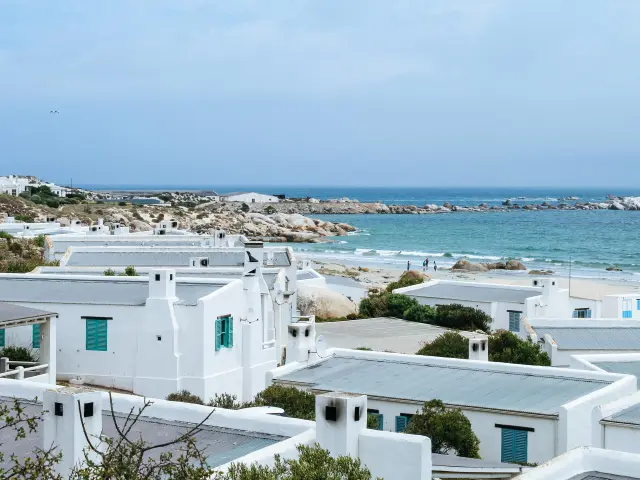
How to get here from Cape Town: Follow R27 north past Bloubergstrand and West Coast National Park. You will soon reach the West Coast Peninsula, where you can visit Paternoster and St Helena Bay.
Our highlights: The Buffelsfontein Game & Nature Reserve is a thrilling safari destination en route. Here, you can spend a night amidst the wilderness, waking up to the majestic roar of lions – a true African experience.
Next, we recommend putting aside some time to admire the natural beauty of the West Coast National Park. Whether you're a birdwatching enthusiast, a biking aficionado, or keen on whale-watching (one of the top locations worldwide to enjoy this activity), this national park caters to all interests.
Paternoster Beach is famous for its pristine sandy beaches, and it's the ideal place to unwind and soak in the sun. The waterfront area is home to great restaurants with some of the freshest seafood you can enjoy in the area.
St Helena Bay is a picturesque destination, offering coastal walks that reveal stunning ocean views. The charming bars and restaurants along the way provide a cozy atmosphere to dine and savor local wines.
You can then conclude your visit to St Helena Bay with a scenic trip to the lighthouse at Shelley Point, the perfect way to wrap up your adventure.
Did you know? Paternoster translates to "Our Father" in Latin. The fishing village is said to have got its name from the prayers of shipwrecked Portuguese sailors.
Things to note: When planning your visit to the Buffelsfontein Game & Nature Reserve, one of the key things to remember is to book your game drive in advance. Game drives in Buffelsfontein are popular, to make the most of your visit, aim to arrive at least an hour before your scheduled game drive.
Timing your visit to coincide with crayfish season is a delicious treat you won't want to miss. Crayfish season typically runs from November to April. Whether it's a beachside barbecue or a fine dining experience, savoring crayfish during its peak season is a culinary highlight of the region.
While in Paternoster, allocate ample time to explore the local artisan shops. These shops are a showcase of creativity and craftsmanship, offering everything from hand-woven textiles and bespoke jewelry to custom ceramics and unique home decor.
Click here to skip back to the top.
Weekend trips from Cape Town (3-5 hours each way)
Ready for a weekend escape from Cape Town? These trips are the perfect chance to immerse yourself in the local arts and cuisine or simply unwind in nature's lap. So pack your bags, set your out-of-office reply, and get ready to discover the wonders that await just a few hours away from the city's hustle and bustle!
6. Cape Town to De Hoop Nature Reserve
3 hours from Cape Town (235 km)
Why you should visit: This road trip from Cape Town to De Hoop Nature Reserve showcases the area's natural beauty and exceptional biodiversity on land and in the adjacent marine reserve.
De Hoop Nature Reserve is a popular nature destination among South Africans and international visitors alike. It is also known as a wonderful spot for wildlife spotting and whale-watching, especially between June and November.

How to get here from Cape Town: This relatively short road trip from Cape Town to De Hoop Nature Reserve will start on N2. Past Bergsig, head southeast on R316 and switch to R319 after driving through Bredasdorp. You will soon reach your destination.
Our highlights: Bredasdorp is a lovely small town you can visit on your way to De Hoop Nature Reserve. This charming town is located in the middle of the countryside, where you can visit art galleries, craft shops, and historic churches.
After driving for several hours through the gently rolling hills and wheat plantations of this part of the Western Cape, you will be able to take a small detour to the coast to Agulhas National Park to visit the southernmost tip of the African continent.
De Hoop Nature Reserve is home to many fascinating animals such as the rare bontebok and also a great place to enjoy whale-watching. If you are visiting during the right season, chances are good that you will be able to admire these gentle giants from the shores of this area.
However, there's also much more to do in De Hoop Nature Reserve, from hiking on sand dunes to trail walking, snorkeling, bicycling, and bird-watching. The reserve is part of the unique Cape Floral Kingdom and is home to hundreds of plant and bird species not found anywhere else in the world.
Whale Trail in the De Hoop Nature Reserve area is a stunning 5-day walking trail. You'll walk along the coast and the mountains, reaching up to the sea. This is a truly unforgettable experience.
Explore the sea, sand dunes, diverse vegetation, and especially birds at the De Hoop Vlei area, a Ramsar Convention-designated wetland. This area used to be the outlet of the Sout River into the sea, though nowadays, De Hoop Vlei consists of a lake surrounded by a diversity of bird species living or nesting here.
Did you know? Although much loved and visited, De Hoop Nature Reserve still offers a chance for a visitor to experience true peace and a sense of wilderness. You'll find pristine beaches and even historical caves in the area.
Things to note: It is important to note that the Whale Trail is quite strenuous and sections of it vary in intensity. For this reason, children below the age of 8 are not allowed on the trail.
If you would like to make a group booking for the Whale Trails, the reservations are limited to bookings of either 6 or 12.
7. Cape Town to Cape Agulhas
3 hours 30 minutes from Cape Town (250 km)
Why you should visit: This is a very scenic road trip route, allowing you to visit some well-known whale-watching destinations in the Overberg region of the Western Cape, namely Hermanus and Gansbaai, before you reach Cape Agulhas, the southernmost tip of Africa.
Cape Agulhas is a wind-swept, rugged area of rocky shores, blue ocean and dramatic beauty. Visitors are drawn here to explore this beautiful and unique natural location, as well as to enjoy the services and sights in the small towns of the Cape.

How to get here from Cape Town: Drive southeast on N2 and merge onto R43 past Bot River. You will then drive through Hermanus and Gansbaai before reaching Cape Agulhas.
Our highlights: Among some of our other recommendations on this list of amazing road trips, Hermanus is one of the best places for whale-watching in South Africa. You might also be lucky enough to see humpback whales, Bryde's whales, Cape Fur Seals, African penguins, and dolphins, among other marine wildlife.
Gansbaai is also known for whale watching and is also home to a dense population of great white sharks. It is possible to do shark cage diving in Gansbaai, or if you'd like something less adrenaline-inducing, you can enjoy horseback riding, hiking, and exploring the beautiful beaches.
Once in Cape Agulhas, it is quite a feeling standing on this ocean shore, with rugged beaches around you and gulls overhead, and knowing that staring out to the ocean, the next stretch of land you would meet is none other but Antarctica!
Cape Agulhas Lighthouse is the second oldest working lighthouse in the country, having been built in 1848. You can visit the small museum here, enjoy refreshments at the little café at the base of the lighthouse, or climb to the very top of the lighthouse tower.
In nearby Struisbaai, explore pristine, white sandy beaches stretching for kilometers and kilometers, or have a meal of fresh seafood at one of the local restaurants supplied by some of the many fishermen operating in this location.
Did you know? The name Cape Agulhas comes from the early Portuguese explorers. Agulhas means needles, and the name is thought to refer either to the fact that the compass needles show no deviation between true and magnetic north in this place.
Another theory refers to the fact that this southern tip of the continent is surrounded by submerged rocks and reefs that have been the fate of at least 130 ships since the days of those early explorers.
Things to note: Although it is occasionally possible to see whales during the rest of the year, the months between June and November are best for spotting southern right whales that are doing their seasonal migrations to their breeding grounds along South African coasts during these months.
Click here to skip back to the top.
Long weekend trips from Cape Town (5-8 hours each way)
Got a long weekend and Cape Town as your starting point? You're set for some truly spectacular escapes. These longer journeys from Mother City are perfect for those craving more than just a quick getaway. Your next great adventure is just a drive away!
8. Cape Town to Namaqua National Park
6 hours from Cape Town (540 km)
Why you should visit: This road trip option takes you north from Cape Town, all the way towards Namibia and the dreamlike landscapes of Namaqua National Park, with diverse plant and animal life, caves, dunes, and much more to explore.
Namaqua National Park is known for its arid, biodiverse environment, pristine coastlines, and especially the springtime flowering of its vast meadows. Visitors from all over the world come to view this spring spectacle in the Karoo, and admire the blossoms of the succulent and other flowers.
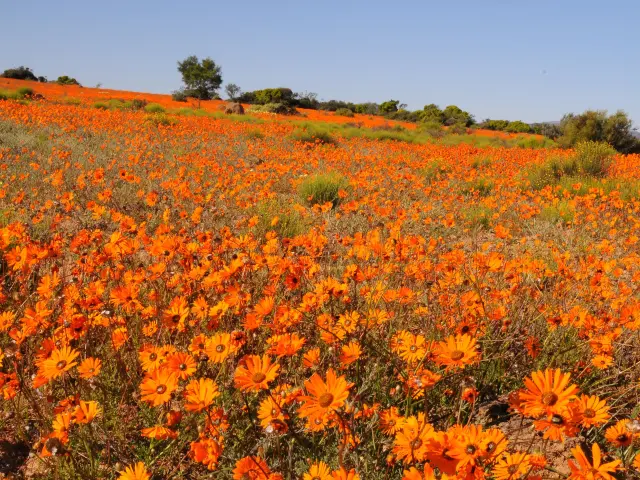
How to get here from Cape Town: This is another easy road trip to follow. Drive on N7 until just before reaching Kamieskroon and turn left to arrive at Namaqua National Park.
Our highlights: West Coast Peninsula is worth a small detour from N7. It is home to unique landscapes, people and communities. Make a tour of game reserves and nature areas, and visit quaint fishing villages and artistic communities.
Paternoster is known for its fishing and the white, West Coast-style buildings (you can read more about this beautiful town above), and Langebaan is like a Greek village with its azure waters, sheltered beaches, and laid-back lifestyle.
Visit Cederberg Wilderness Area on the way to Namaqua National Park to view San rock art and enjoy hiking, rock climbing, or picnicking. You can also find more information about this area in our dedicated road trip section above.
Skilpad Walking Trail is perhaps the most popular walk in Namaqua National Park. It starts and ends at the Skilpad office, and it provides spectacular views of the "flower carpets".
On the coast, visit the untouched beaches, or some of the many caves found here. The Spoeg River Caves are places where shell middens can be found from 1,900 years ago, indicating the presence of hunter-gatherers who lived here in those times.
Also on the coast, you will be able to visit the seal colony known to live in this area. Thousands of Cape fur seals live here, basking in the sun and swimming in the ocean waters.
Did you know? Regular winter rains make this semi-arid region bloom uniquely during spring. They also help support the diversity of life found in this natural area; amphibians and reptiles thrive here, and mammals include klipspringer, aardvark, leopard and baboon, among many other species.
Things to note: With the abundance of flowers during the spring months, it might be tempting to pick a few. However, many of the plant species here are protected, and a fine may be issued for those picking flowers - rather admire them from a distance!
A 4WD vehicle might be a good idea for this road trip if you wish to explore all sections of Namaqua National Park. The closest petrol station and ATM are in Springbok, about 90km from the national park.
9. Garden Route to Stormsriver
6 hours 45 minutes from Cape Town (585 km)
Why you should visit: Garden Route is known for blue lagoons, small but vibey coastal towns, fun theme parks, and animal sanctuaries. On this drive from Cape Town, you can explore breathtaking canyons and river valleys and take hikes through the ancient Afromontane forests or drier but highly diverse fynbos vegetation that are unique to the area.
Nearing Mossel Bay, you'll notice the landscape changing from the vast, open lands of wheat plantations and fields to the lush, green forests, rolling foothills, and river valleys of the Garden Route.
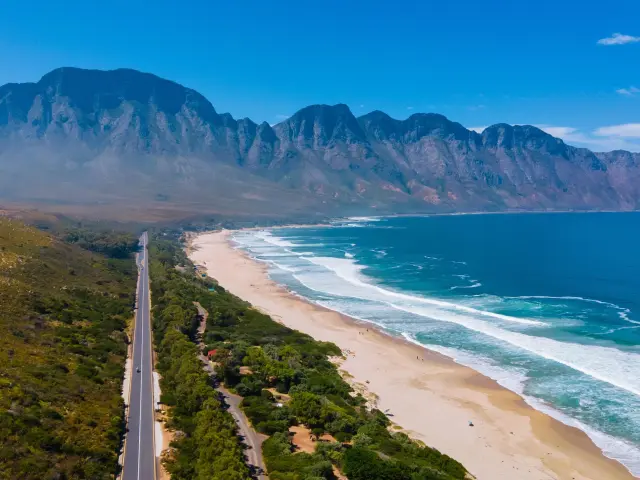
How to get here from Cape Town: This popular road trip will take you out of Cape Town on N2, which you will follow until you reach Stormsrivier.
Our highlights: George is the second big city in the Garden Route area when travelling from Cape Town. This lovely city has malls, farmer's markets, and you'll also find some true gems in this fast-growing city.
Visit the Outeniqua Transport Museum to learn about the history of railroads and trains in the Garden Route, or, if you're into hiking, Cradock Peak overlooking the city is a strenuous but extremely beautiful 10-hour hike up and down the tallest peak of the Outeniqua Mountain Range.
Wilderness is a small town known for its live music, restaurants, beaches, quaint cafés, bohemian hostels, and stunning hikes up rivers and through lush forests. Half-Collared Kingfisher Trail is one of these famous walks, where you can spot the stunning Knysna turaco, baboons, vervet monkeys, bushbuck, and boomslang.
Knysna is the only location in the Garden Route where a single forest elephant is still said to roam, a relic of herds that lived here until some decades ago. A must-visit spot in Knysna is The Heads, with impressive cliffs connecting the sea to the lagoon.
Plettenberg Bay is a beautiful town with luxurious hotels and wonderful restaurants and cafés. Robberg Peninsula is perhaps the most well-known landmark near the town, which is a fantastic place for a hike, and there are also caves to explore where the early Khoisan people lived.
Nature's Valley is another jewel of the Garden Route. It is part of Tsitsikamma National Park, a large stretch of indigenous forest containing diverse plant and wildlife species. This forest-covered town and location also has a stunning beach and mesmerizing yellowwood forests where you will feel awed by the sheer size and beauty of these forest giants.
Stormsriver, also part of Tsitsikamma National Park, is a small Eastern Cape locality that marks the Garden Route's eastern end. You'll find several enchanting forest walks here, or you can visit Stormsriver Rest Camp by the ocean, where trails take you to aloe groves and waterfalls along the shore.
Did you know? Garden Route has been popular amongst tourists at least since the 1960s. Back then, you could take a passenger train from one location to another along this coastal region. Since then, the train stopped operating, but train tracks still connect the towns to each other.
Nowadays, the tracks are mainly used by fishermen; for the average modern traveler, rental cars or long-distance buses are the way to go to get from place to place on the Garden Route.
Things to note: The highways and other larger roads along the Garden Route are in good condition. However, some of the sections of the highway contain sharp curves in hilly places; also, during the high season (December-January) roads can get rather busy. Keep vigilant in traffic.
If you would like to explore further into the lovely communities located on the Garden Route, certain guesthouses and attractions may require you to drive on smaller dirt roads.
10. Cape Town to the Karoo
7 hours 45 minutes from Cape Town (650 km)
Why you should visit: Unlike the other road trips on this list, this journey from Cape Town to the Karoo will allow you to explore the inland side of the coastal mountain ranges of the Western Cape: Little Karoo and Great Karoo. Karoo is a breathtakingly beautiful land of open vistas, ragged red mountains, unique vegetation and wildlife, and historical towns.
Karoo offers something to a visitor at any time of the year, including in winter, when you may view snow-peaked mountains in the distance, or early spring, when wildflowers decorate this highly diverse desert-like environment.
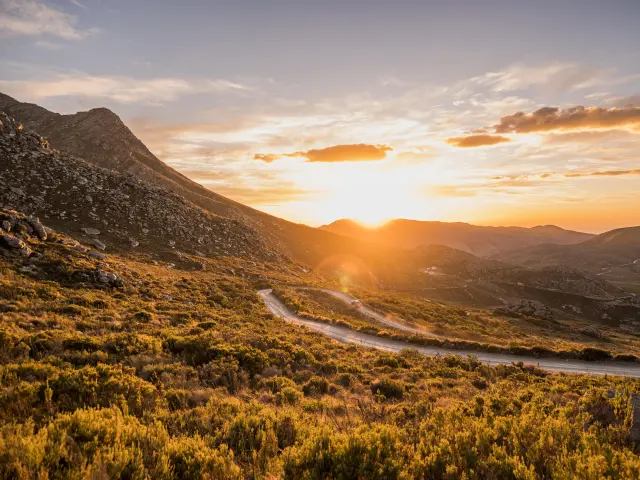
How to get here from Cape Town: To reach the Karoo region, head out of Cape Town on N1 and drive through Paarl and Worchester. Here, merge onto R60 and then R62. Take a short detour to Little Karoo before continuing on the route.
Past Oudtshroorn, hop onto N12 and follow it north to reach the Karoo.
Our highlights: Driving from Cape Town, you'll cross over the Langeberg Mountains at Montagu. It is a vibrant town known for mountaineering, nuts and orchards, and is one entry point into the Little Karoo, the smaller of the inland desert areas separated from the sea and each other by mountain ranges.
In Little Karoo, you'll pass by wondrous mountains, rock formations, and desert landscapes. You can pop into traditional farm stalls in the little towns en route, and you can also visit Oudtshoorn, one of the main cultural and commercial centers of the Little Karoo.
North of Oudtshoorn, we highly recommend visiting Cango Caves, which will be an otherworldly underground experience if you have enough time on your hands.
Swartberg Pass is one of your possible gateways into the Great Karoo. This high mountain pass is a scenic drive in and of itself, and the views from the top to the direction of the Outeniqua Mountains in the south and the Great Karoo to the north are breathtaking.
Visit Prince Albert on the way, an artsy town filled with friendly people and great cafés, surrounded by vineyards and olive and fruit farms. Frans Pienaar Museum features local history exhibits, including fossils.
Beaufort West is known as the "Capital of the Karoo" and is the largest town in the Great Karoo. Here, you can visit the fascinating Beaufort West Museum, chrome to historic displays and stories of the town's people, churches, and events.
If you are craving to spend some time in the great outdoors, head into Karoo National Park for dramatic views of the semi-arid desert and eroded mountains. You can also spot fascinating wildlife including buffalo, black rhino, lion, eland, and Cape Mountain zebra.
Did you know? Though hard to believe observing the semi-desert-like conditions of the Karoo nowadays, this vast area used to be an inland sea 250 million years ago. Once the climate warmed, the sea retreated and eventually gave way to the grasslands that supported massive migrating herds of big game.
Since the arrival of the European settlers in the early 1700s, many of these big animals were unfortunately started to become endangered. Luckily in the last 50 years, some pockets of the Karoo have been protected to maintain wildlife species and rehabilitate some of the eroded lands.
Things to note: Swartberg Pass is travelled along a small and meandrous dirt road. Most cars will be able to get through the pass, but you'll need to take care and be aware of the oncoming traffic.
Otherwise, some distance to the east, Meiringspoort is another gateway to the Great Karoo, and here you can cross along a well-maintained paved road.
Distances in the Little and Great Karoo are long between towns, and if you plan on taking any detours, it is a good idea to fill up with fuel and food when you can.
These areas are now more desert-like environments, but both used to be lands where herds of antelope and other big game would migrate and graze. Though only remnants of those times now remain, you can still spot wildlife, such as ostriches, springbok, other antelopes and baboons.
Click here to skip back to the top.
Longer trips from Cape Town (Over 8 hours each way)
Brace yourself for epic road trip adventures beyond the 8-hour mark. These extended trips are your ticket to exploring some of the most magnificent and awe-inspiring destinations, including iconic cities like Johannesburg and Durban and the inspiring landscapes of Drakensberg.
11. Cape Town to Gqeberha
Via Route 62
8 hours 45 minutes from Cape Town (780 km)
Why you should visit: This road takes you east from Cape Town will take you through some of Western Cape's wine region into and through the Little Karoo, and will end up in Gqeberha in the Eastern Cape, a historic coastal city that serves as a gateway to wonderful wildlife reserves.
Gqeberha, located on the shores of Nelson Mandela Bay, has some beautiful beaches, historic sites, museums, and other cultural attractions, making it a fascinating holiday destination. It is also known as a windy city, and as one of the friendliest South African cities.
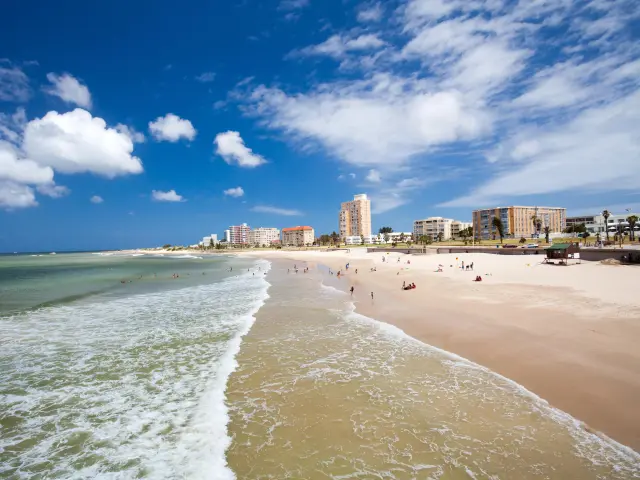
How to get here from Cape Town: Follow N1 out of Cape Town and through Paarl, then switch to R60 past Worchester. Drive through Robertson and Oudtshoorn, where you will switch to N12 and then N9 briefly before hopping back on R62.
Drive past Garden Route National Park, and soon you will reach Gqeberha.
Our highlights: Robertson is a lovely town in the heart of the wine route section of Route 62. Located right next to the majestic Langeberg Mountains, this town has art galleries and some of the most popular wines come from this region. Take a "wine safari" to visit some of the finest producers in the area!
Oudtshoorn in Little Karoo is the main cultural and commercial town of the area. It has interesting art galleries and museums to explore, or you can visit natural highlights in the vicinity, such as the mesmerizing Cango Caves.
Before reaching Gqeberha, take a south turn at Humansdorp to visit the coastal towns of St Francis Bay and Cape St Francis. These idyllic coastal towns have a pace and life of their own; you'll find lovely restaurants and breweries in the picturesque St Francis Bay, and in Cape St Francis, you can visit a beautiful old lighthouse, enjoy a fabulous surf, or walk on a quiet, broad, white beach.
When you reach Gwerberha, we recommend visiting the Nelson Mandela Metropolitan Art Museum. Afterwards, see if you can find Route 67. a collection of 67 art pieces on Donkin Street that celebrate the years that Nelson Mandela devoted to his service to the public.
These art pieces include visual arts, urban design, old Victorian churches and massive silver pipes that make music by catching the famous winds of Gqeberha.
About an hour's drive north of Gqeberha is Addo Elephant National Park. This is one of the best places in the Eastern Cape for viewing the big five: lions, Cape buffalos, rhinos, leopards and, of course, elephants. This large national park is a beautiful place to spend at least a day or two.
Did you know? Gqeberha is an isiXhosa name for the city that used to be called Port Elizabeth. If you are visiting and unsure how to pronounce it, you can always ask a local!
Things to note: As with many towns and bigger cities, it is always a good idea to keep your wits about you with regards to where you go and how you handle your personal belongings because of the possibility of encountering pickpockets and small theft.
12. Cape Town to Hogsback
11 hours 15 minutes from Cape Town (1,030 km)
Why you should visit: On this longer road trip, you'll get to visit the vineyards of the Western Cape, then will enter Little Karoo, and finally drive past the historic towns of Great Karoo, such as Graaff-Reinet, on the way to your tucked-away holiday destination,
Driving into Hogsback from the surrounding area feels like entering another world. In Hogsback, you can enjoy horse rides in the indigenous forest, hike past meandering streams and giant yellow woods, and spot one of the three primate species in South Africa, the Samango monkey.
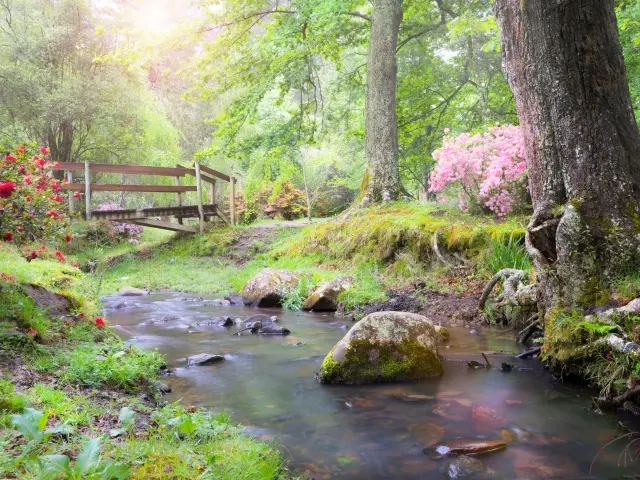
How to get here from Cape Town: On this road trip, you will head to Gqeberha on N1 and then R62. Past Gqeberha, head northeast on N2. Once you reach Botha's Ridge, switch to R67 and drive past Great Fish River Nature Reserve.
You will soon arrive at Fort Beaufort, follow R63 and then R345 to arrive at Hogsback.
Our highlights: On your way from Cape Town to Hogsback, you can enjoy sampling wines in Robertson while driving through the winelands of the Western Cape; or have a stop at Montagu.
If you have time, you can also visit Graaff-Reinet to explore some of the many historic sights in this old town, such as the Graaff-Reinet Museum and the Groot Kerk - Dutch Reformed Church.
An optional detour is visiting Mountain Zebra National Park near Craddock before reaching Hogsback. Other wildlife now present in the park include aardwolves, chacma baboons, caracals, and, more recently, lions.
Hogsback is a magical place of mountains and forests. It is located on a high plateau amidst the Amathole Mountains, and surrounded by indigenous afro-montane forests.
Some of the shorter or longer hikes in Hogsback are a must for any visitor; they will take you to stunning waterfalls, past meandering streams amidst hundreds of years old forest giants, and you can spot wildlife from monkeys to turacos, and chameleons to colorful butterflies.
From the viewpoints, you will enjoy views over the Amathola Mountains and the surrounding lands of the Great Karoo. Our favorite hikes in this area are Madonna & Child Waterfalls, and Kettlespout Falls hike.
Hogsback Arboretum is a beautiful living tree museum - among other plants and meandering trails, you can admire the Giant Californian Redwoods that were planted here decades ago.
Did you know? It is said that J.R.R. Tolkien got some of his inspiration from Hogsback for his famous trilogy, The Lord of The Rings. We believe this to be true, because, without any doubt, this mysterious place seems like the sort where elves and hobbits might reside!
Hogsback was named for three ridges on the nearby Amathola Mountains that resemble the outline of a hog's back. For the local Xhosa people, these mountains are a spiritual domain.
Things to note: Remember to fuel up regularly on your road trip; distances between towns and petrol stations are often long, especially in Little Karoo and Great Karoo regions.
It is a good idea to keep your eyes on the road and be careful; there are often wildlife or domestic animals near or crossing the roads, and the road conditions at parts may not be quite as optimal as in the Western Cape, though they are generally in a good condition.
13. Cape Town to Drakensberg
15 hours 30 minutes from Cape Town (1,455 km)
Why you should visit: This road trip will take you from the coastal scenery of Cape Town to Drakensberg, home to the vast mountain range that is sometimes referred to as the "roof of South Africa".
In this World Heritage Site you'll find shorter hikes or can go hiking in the mountains for weeks,. You will also enjoy dramatic, panoramic views and admire imagination-spurring rock formations, and spot unique plant and animal life that will fascinate you.

How to get here from Cape Town: Drive out of Cape Town on N1 and follow this road until Bloemfontein. Switch to N5 past Winburg and dip north at Harrismith on R74 to reach the majestic Drakensberg.
Our highlights: Karoo National Park, right on the doorstep of Beaufort West, is a fabulous place for viewing wildlife, such as black rhinos, hartebeest, springbok, and buffalo, as well as many reptiles, amphibians, birds, and insects.
If you enjoy history, the War Museum of the Boer Republics Bloemfontein is a must-visit destination. It is the only museum in the world that focuses on the Anglo-Boer Wars that took place at the turn of the 20th century.
Cathedral Peak is one of the most famous and beautiful peaks in the Drakensberg Mountain Range. You can enjoy walks and viewpoints here, best reached from the historic Cathedral Peak Hotel.
Giant's Castle is the best place to explore the central Drakensberg, where you can enjoy hikes for every fitness level.
Kamberg is a great location for viewing rock art. The art is well preserved here, you can take a guided tour to learn more about the people who created and what these drawings symbolize.
Did you know? At 948 meters, Tugela Falls is the second-highest waterfall in the world, after Angel Falls in Venezuela. Tugela Falls can be reached via a fairly challenging, 4-hour hiking route - it sure is worth it.
Things to note: Keep in mind that the Drakensberg region experiences quick shifts in weather. If you're hiking here, be prepared with gear for any weather; you might be surprised by a thunderstorm or downpour.
14. Cape Town to Johannesburg
15 hours 30 minutes from Cape Town (1,490 km)
Why you should visit: This road trip route from Cape Town will take you across much of South Africa and to Johannesburg, known as the "Gold City", due to playing an important part in the gold rush of South Africa.
Johannesburg is also the most populous city in South Africa; and you can expect to find many museums and landmarks, as well as world-class restaurants in this urban metropolis.
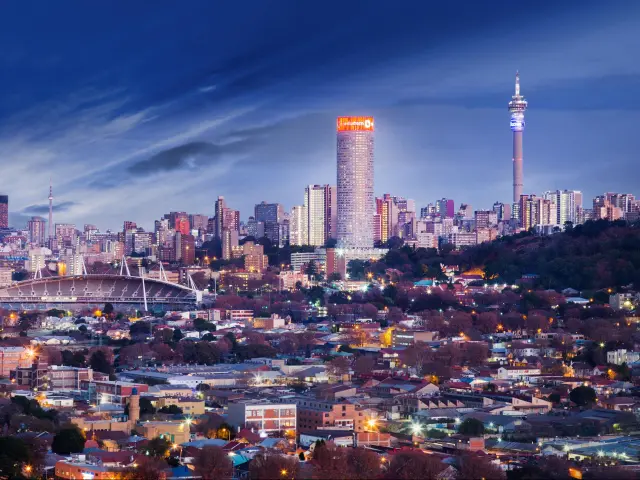
How to get here from Cape Town: You will follow N1 almost all the way to your destination on your road trip with just one detour past Beaufort West - here switch from N1 to R61 to visit Graaff-Reinet, and then return on N1 to reach Johannesburg.
Our highlights: On the way, visit Karoo National Park to view some amazing wildlife present in this semi-desert environment; you can encounter black rhinoceros, zebra, ostrich, hartebeest, and several other species.
Graaff-Reinet is known for well-preserved historic buildings, museums that tell the stories of indigenous peoples and early settlers alike, and national monuments, of which there are about 220 in the town.
Looking for outdoor adventures? You will find Camdeboo National Park a short drive from the town. In addition to being conveniently close to Graaff-Reinet, this national park is a breathtakingly beautiful, rugged nature area with hikes, a game reserve, and scenic viewpoints.
Once you are in Johannesburg, you will find many educational museums and landmarks to visit to learn about the history of this big city. One of the most poignant ones is the Apartheid Museum, detailing the history of 20th-century South Africa.
For a local experience, head over to LoCrate Market in Soweto (South-Western Townships of Johannesburg). This is a popular market frequented by creative minds, and you can enjoy viewing local art, crafts, and fashion, sampling delicious foods, and listening to live music performances.
Did you know? Johannesburg has been a city of innovation ever since its inception. More recently, many innovators and companies still call "Jo'burg" home. This bright city is the birthplace of SpaceX and Tesla founder Elon Musk, as well as the well-known comedian Trevor Noah.
Things to note: Over the years, Johannesburg has transformed significantly, expanding into a vibrant urban area. With this growth, like many major cities, comes the need for mindful travel. When exploring the dynamic streets of Johannesburg, it's wise to stay aware of your surroundings.
To navigate the city easily and safely, consider using reliable transportation options. The Gautrain service offers convenient and secure ways to travel from one destination to another if you'd like to leave your car behind for a while.
READ MORE - Road Trip from Cape Town to Johannesburg
15. Cape Town to Durban and St Lucia
22 hours 20 minutes from Cape Town (1,895 km)
Why you should visit: This longest road trip on this list is an epic coastal journey from Cape Town to Durban and St Lucia. Along the way, you can visit the quaint towns and mesmerizing forest walks of the Garden Route, make a stop on the coast in the Transkei and explore the vibrant, tropical Durban.
St Lucia is best known for iSimangaliso Wetland Park, a World Heritage Site surrounding this small but popular holiday town. Hippos are known to roam the streets of the town every now and then!

How to get here from Cape Town: Even though this road trip from Cape Town to Durban is the longest one on our list, it is one of the easiest to follow - you will drive on N2 all the way from Cape Town to Durban and then to St Lucia.
Our highlights: Take your time driving the length of the Garden Route, exploring the vibrant small towns, beautiful areas with lush forests, and gorgeous river valleys along the way - not to speak of the long, sandy beaches with mountains always as your backdrop.
While driving past the Transkei, make a stop at Kei Mouth to admire the expansive views of the Kei River. Exploring further, you can also see the traditional clay huts the Xhosa people still live in in their ancestral homeland.
In Durban, take a drive to the Durban Beach Front Promenade for a leisurely stroll. Afterwards, you can stop by one of the restaurants and bars nearby. Looking for something more active to do? If so, you can swim and sunbathe on the sandy beach.
St Lucia is home to the largest population of free-roaming hippos in the country. One great way to view these majestic animals, as well as crocodiles and other wildlife, is on a boat tour.
iSamangaliso Wetland Park is one of the main highlights of St Lucia. This large protected area is home to hippos, crocodiles, pelicans and flamingos. In the nearby Western Shores and Charters Creek areas, you can also spot elephants, leopards, and giraffes.
If you'd like to learn more about the lives and traditions of the Zulu people, we recommend visiting the Veyane Cultural Village.
Did you know? The provinces of Gauteng and KwaZulu-Natal are often called the "Cradle of Humankind" because they contain the largest amounts of ancient evidence of humans living in these areas.
In the area surrounding St Lucia, relics that belonged to people living here as long as 130,000 years ago have also been found.
Things to note: St Lucia is renowned for its incredible wildlife, and respecting their habitat is key to a safe visit. Heed local warnings and avoid swimming in areas known for crocodiles.
Similarly, if you're lucky enough to spot hippos, maintain a safe distance. While they are fascinating to watch, these majestic creatures are best admired from a distance.

